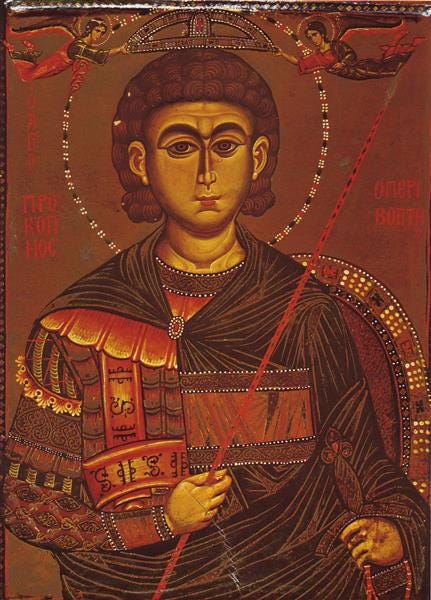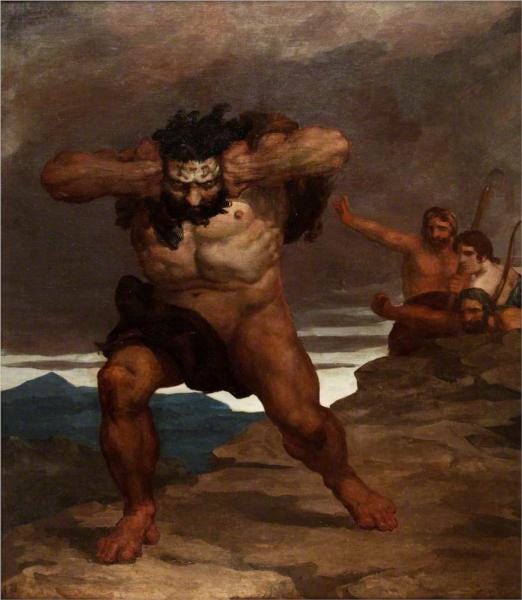Daily Readings | 27 Feb 25 | The Ending of Jude; The Passion in Luke (cont.)
Scripture Readings: Jude 11–25; Luke 23:1–34, 44–56
I was caught up with errands and children yesterday, so I was not able to write something up. Worry not, though, about us concluding Jude. The readings were from Joel, so we will be able to finish our brief look at the short epistle today.
Saint/Feast Day: Procopius, Confessor
He was born in the Decapolis of Palestine in about the eight century, and in his youth led a life of monastic rigor. When Emperor Leo banned icons, many in the Church rose against the decree, continuing to venerate icons. Procopius also vigorously defended the holy use of icons, leaving the safety of his monastic retreat to crusade for the truth. He rallied many monks to the cause who went about, preaching about Christ and denouncing the iconoclast heresy. The Emperor in retaliation persecuted the monks and Procopius himself was imprisoned for a year. When he continued to preach even in prison, he was exiled. After Emperor Leo died, he returned and continued his struggle in Constantinople itself. He went abroad, urging all the clergy to be resolute for the truth. Finally he returned to his monastery. He died in peace in the ninth century.
L. Farley, Eastern Saints.
Readings: Jude 11–25; Luke 23:1–34, 44–56
My goal with these daily reading reflections is to have self-contained thoughts that are not contingent on one another. That said, it is difficult to achieve, in part, because the calendar goes through books passage by passage. Today’s will definitely be dependent on my most recent Daily Reading, though, since we are finishing the second half of the letter, and the scriptural break was in the middle of the argument.
As such, it is only about an 11min read—per SubStack’s estimation—so I encourage reading that first before reading the conclusion of Jude here. If not, I will provide a short overview.
This specific analysis will only concern v. 11, which may seem absurd, but I have spent quite a bit of time here. To look past this would cover far more ground than what these Daily Reading reflections are intended to do. If you would like me to continue with this mini commentary—if it is that—let me know in the comments.
Summary of Jude 1–10
The letter opens with a typical epistolatory introduction (1–2), which is followed by the reason and the purpose of the letter (3–4): Defend the Faith and beware of False Teachers.
What did these “ungodly” people do? They distorted the grace given them and rejected Christ (4).
Jude then provides examples from Jewish tradition and Scripture concerning what wrongs they have committed (5–7):
The Exodus and destruction of those who doubted (Numbers 14, 26), v. 5
The Fall of Angels, bound in “eternal chains in the nether gloom” (Gen 6:1–4, though relies of developed tradition: 1 Enoch 6–19), v. 6
Sodom and Gomorrah, “undergoing a punishment of eternal fire” (Gen 19), v. 7
These examples show that the apostates—probably—are guilty of disbelief, rebellion, and sexual immorality.
Jude transitions to a direct condemnation (8): “Yet in like manner these men in their dreamings defile the flesh, reject authority, and revile the glorious ones” (RSV), which then is followed by an example from the Archangel Michael and the Devil disputing over Moses’ body (9–10).
What follows, will be further examples of condemnation.
More Examples of Judgment and Condemnation from the OT (11)
As in Jude 5–7, the epistle writer now lists another string of parallels from the OT to condemn the “ungodly” people:
Woe to them! For they walk in the way of Cain, and abandon themselves for the sake of gain to Balaam’s error, and perish in Korah’s rebellion.
This is a typical Woe-formula that we see in the NT, such as Jesus in the Gospels (e.g., Matt 11:21, 18:7, 23:13–16, 26:24; Mark 13:17, 14:21; Luke 6:24–26; 10:13, 11:42–47; 17:1; 21:23, 22:22), and is also a prevalent aspect of 1 Enoch 92–105.
“The Walk in the Way of Cain” (Gen 4:8)
The most easily recognizable figure in this list is the son of Adam and Eve who murdered his brother Abel: Cain.
In the intertestamental period, Cain’s narrative, character, sin & punishment, and legacy are developed and expanded in Jewish literature—e.g., the Deuterocanonical books, the Old Testament Pseudepigrapha, the Dead Sea Scrolls, and Philo & Josephus.
His Death:
And at the close of this jubilee Cain was killed after him [Adam] in the same year; for his house fell upon him and he died in the midst of his house, and he was killed by its stones; for with a stone he had killed Abel, and by a stone was he killed in righteous judgment. (Jubilees 4:31–32
His Cursed Lineage:
And he [Raphael] said to me: “This is the spirit which went forth from Abel, whom his brother Cain slew, and he makes his suit against him till his seed is destroyed from the face of the earth, and his seed is annihilated from amongst the seed of men.” (1 Enoch 22:7)
Blamed for the Flood:
But when an unrighteous man departed from her [Wisdom] in his anger, he perished because in rage he slew his brother. When the earth was flooded because of him, Wisdom again saved it, steering the righteous man [Noah] by a paltry piece of wood. (Wisdom 10:3–4—the temptation to relate “paltry piece of wood” to the cross is great)
Representation of Greed:
Cain, whose name means ‘possession,’ is a symbol of the mind that thinks it possesses all things… He killed Abel, whose name means ‘offering to God,’ because the foolish mind destroys the better part that seeks God. (Philo, On the Posterity and Exile of Cain 1-2)
Creator of Agricultural Tools and Societal Corruption:
Cain, after this, became worse in wickedness… He was the first that invented the plow… and he changed the world into craftiness and deceit. (Josephus, Ant. 1.2.2)
It would be too far to assume that the accusation here against the apostates is murder. Rather, it would not be stretch to believe that Jude is aware of this developed tradition about Cain, and they have fallen into depravity: corruption and greed; metaphorical children of this cursed figure. In short, this is a condemnation for general corruption of the body of Christ.
“Abandon[ed] themselves for the Sake of Gain to Balaam’s Error”
Balaam is probably less recognizable—except for maybe the donkey scenario (Num 22:21ff.)—since his story comes from Numbers, which most—when/if they read it—have their eyes glaze over from all the numbers.
His account starts in Numbers 22–24 where he is commanded by Balak, a Moabite king, to prophesy against Israel, but he is unable to do so.
His condemnation comes in Num 31:16
Behold, these caused the people of Israel, by the counsel of Balaam, to act treacherously against the Lord in the matter of Pe′or, and so the plague came among the congregation of the Lord.
This increase in worship of Baal at Peor due to Israelite men having sexual relations with Moabite women is recorded in Numbers 25, but there is no mention of Balaam. Rather, it is understood based on the text that he was blamed for this increase, which was certainly the understanding in the first century as Josephus shows:
Balaam, seeing he could not curse them… advised Balak to send the Midianite women to seduce the Israelites into idolatry… This counsel succeeded, and many of them fell into sin… Thus Balaam, though he blessed them with his mouth, cursed them with his advice. (Ant. 4.6.6)
Philo (On the Cherubim 32-33) describes him as
Balaam is a symbol of a vain people, puffed up with arrogance… He speaks the words of God, but his mind is far from righteousness.
Balaam’s oracles are recorded in Numbers 23–24, which have christological implications. The Qumran community, in particular, saw messianic expectations expressed in these sayings:
“And a star shall come forth out of Jacob, and a sceptre shall rise out of Israel…” [Numbers 24:17]… This is the prophecy of one who hears the words of God, spoken by Balaam son of Beor. (4Q175 lines 21–30)
Aside from that, Balaam is a negative figure, whose condemnation relates to sexual immorality—just like Sodom and Gomorrah—and false worship. This could be a tacit comment on the actions of the infiltrators Jude is chastising. They have led members astray through sexual immorality and their denial of Jesus’ lordship.
“And [They] Perish in Korah’s Rebellion”
Another example from Numbers, specifically chapters 16–17, Korah and a group of 250 rise up against Moses and challenge his authority. The result?
|31| And as he finished speaking all these words, the ground under them split asunder; |32| and the earth opened its mouth and swallowed them up, with their households and all the men that belonged to Korah and all their goods. |33| So they and all that belonged to them went down alive into Sheol; and the earth closed over them, and they perished from the midst of the assembly.
For rebelling against Moses and Aaron and attempting to usurp their authority over the people, they are punished by being swallowed up by the earth.
The punishment of the 250—consumed by fire (Num 16:35)—is conflated in Sirach 45:18–19, which is reminiscent to the punishment in Jude 7 concerning Sodom and Gomorrah:
Outsiders conspired against him [Aaron], and envied him in the wilderness, Dathan and Abiram and the company of Korah, in their wrath and anger. The Lord saw it and was not pleased, and in the wrath of his anger they were destroyed; he wrought wonders against them to consume them in flaming fire.
Ultimately, Jude is wishing for divine wrath against these “ungodly persons” who have attempted to challenge authority. This interpretation concerning Korah and his crew can be witnessed in Philo and Josephus:
Korah, whose name means ‘baldness,’ signifies the mind stripped of wisdom… He rose against Moses, the lawgiver, and Aaron, the priest, seeking to usurp their roles, but was swallowed up by the earth, showing that the soul devoid of virtue falls into ruin. (Philo, On the Preliminary Studies 107–109)
Korah and his company… dared to claim equality with the holy ones… and the earth opened and swallowed them, a sign that rebellion against the divine plan brings disaster. (Philo, On Rewards and Punishments 79–80)
The people were astonished at this punishment… and God caused fire to come out of the earth and consume the rest of the two hundred and fifty… proving Moses’ authority was from Him. (Josephus, Ant. 4.3.2)
Now, it is unclear if this is connected with Jude 8, where he discusses the rejection of authority. It seems clear that he intends they rejected the authority of Jesus with the play on “Lord” here in the Greek.
Here, though, with the example of Korah, it would appear ecclesiastical authority is in mind. Afterall, the rebellion was against Moses, specifically, though the text reads as contention with God as well.
Synthesis
These additional three examples of villains in the OT parallel what was seen previously in Jude 5–7. Both emphasize rebellion, improper worship, and sexual immorality. Both lists include punishments for these sins.
At the core of the issue here, Jude is lambasting the corruption of the Church. These infiltrators, apostates, and godless people have besmirched the grace that God had given them by denying the authority of Christ. While doing so, they also led others to rebellion, seemingly, and corrupted them with sexual immorality.
Cain represents improper worship; Balaam aligns with temptation and sexual immorality, as well as improper worship; and Korah epitomizes sedition.
So, we see in these OT traditions, that these False Teachers are the embodiment of corruption. They were, in a way, prefigured in history, and Jude hopes for a swift and decisive divine punishment: “The Lord Rebuke You” (Jude 9)
If you have enjoyed this brief reflection on today’s Byzantine readings and wish to read more about NT studies, would you kindly share this post and subscribe.
And, if you would like me to write more on the rest of Jude, let me know in the comments. I have thoroughly enjoyed looking through this short epistle, and I may do so regardless, should time allow.









